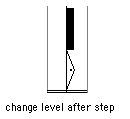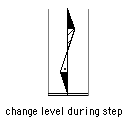The Theory
Behind...
Steps
Direction
for steps is the direction in which you travel (away from your previous position).
You should sense your whole body moving in the direction indicated. More
Level
for steps is based on natural walking (middle level). Low level means to lower,
stepping down onto a bent knee (demi plié, in ballet terms). High level
means to rise, stepping up onto the ball of your foot (relevé, in ballet
terms). More
Distance
for a step is based on your own usual amount of space between steps in walking.
To find your step length, walk in an unhurried but purposeful way until you
fall into your natural stride. This should be the length of your middle-level
forward step. The size of steps in different directions and levels, if unforced,
will vary slightly from this individual "standard."
Each
step represents a complete transfer of your weight
from one foot to another.
Timing
for a step includes all aspects of transferring weight from one foot to another,
including the moment of contact (represented by the beginning of the direction
symbol), taking weight on your new support (about 1/2 way through) and release
of your opposite foot in preparation for another step (at the end of the direction
symbol).
| |
|
When there is a
pause in traveling and your weight
remains on one leg, a pause or "hold weight" sign follows
the direction symbol.
|
|
|
When you have weight
on both feet (for example, one foot closes while the other retains weight)
the pause sign may be centered over both.
|
|
|
A subsequent step
on either foot will cancel the pause sign.
|
|
More
about directions for steps:
Directions relate
to your own body front. Right side steps will be toward your right side,
backward steps to your back, etc., no matter how you are oriented in the
room or performance space.
|
If you travel to
your side with several steps, you will have to cross in front or in
back. A pin, which "points" forward or backward, shows which
way to cross (see the grapevine
in the section, "try
it out")
|
|
|
An alternate way
of travelling to your side is to step side, close, side, close.
|
|
|
For steps on the
diagonal, try to resist turning into the direction of stepping. Keep
your diagonal steps on the angle between forward and side, or between
backward and side.You will not need pins with diagonal steps to show
crossing; you should cross in the most natural way.
|
|
|
A step "in
place" is directly underneath you, like marching in place. Release
your foot before stepping on it, and make a complete transfer of weight
onto your foot, the same as for steps in different directions.
|
|
More
about levels for steps
You can
change level either after or during a step:
|
If
you change level after you finish a step, the symbol for "in
place" shows the change of level. Your weight will already
be over that leg.
|
|
|
|
If
you change level during a step, the direction symbol shows the
two different levels, producing an undercurve or overcurve.
|
|
|
|
|
|
Theoretical
background
The two columns at the center
of the staff give important information about how the body as a whole is mobilized.
Weightbearing movements, whether on the feet or other parts of the body, are
shown in these "support" columns.

History note:
The simplification of
complex actions such as steps reflects the notation’s early use for
nonprofessional dance, with an emphasis on "natural" movement.
Helen Priest [Rogers], who studied the notation in the 1930s, soon after
it was first developed, discusses expectations for the manner of performance
when an action is written simply: "One of the basic principles of this
system is that the most natural movements require the least number of signs.
This does not mean that a natural movement is not a complicated one, but
that only the essential parts of a movement are notated, the rest not notated
is to be done in a natural manner." (Helen Priest, 1937: The Construction
of a Course in Dance Notation (Laban Method).
Although what is considered
to be "natural" varies among cultures and dance styles, and although
movement varies according to body size and build, Labanotation is meant to accommodate
the individual.
Transfer of weight, from
foot to foot and in various directions, involves a complex sequence of joint
actions. It is also a very common activity: walking. It can be represented simply,
as a series of steps, or in the complexity of joint analysis, as needed.









